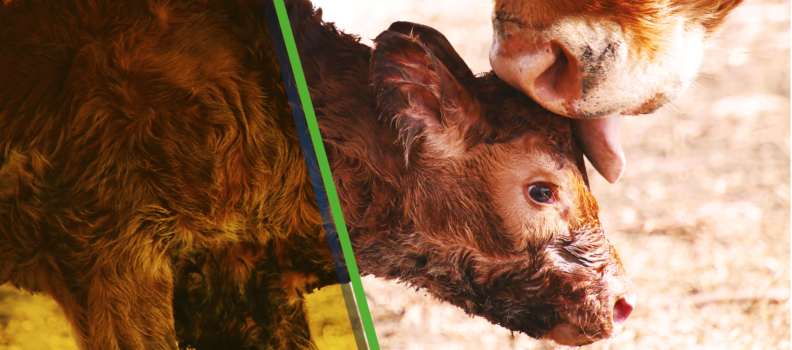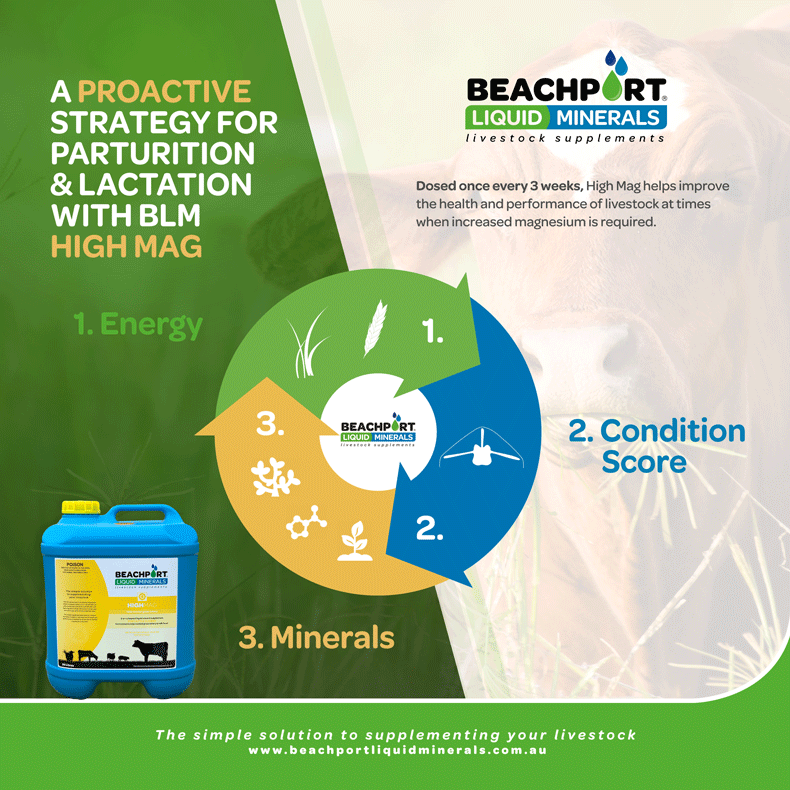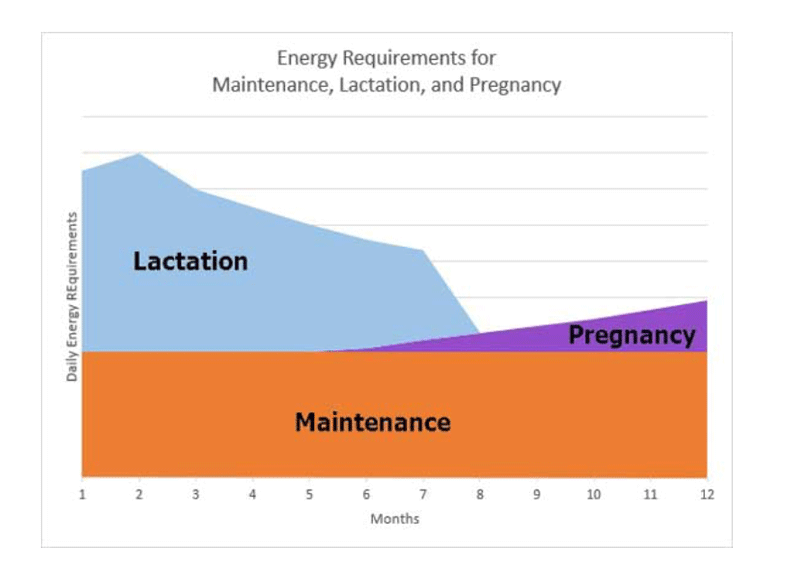Mag March // Magnesium is Key for Autumn Calving & Lambing

It’s Mag March! Annually, this time of year usually presents a break in season, so we have dedicated a whole month to bring you information on Magnesium availability in short green feed at Autumn calving and lambing.

What steps can you take to prevent metabolic diseases during this critical time of production?
Autumn Calving and Lambing can pose management concerns when there’s been an early break and livestock are ‘transitioning’ from dry to green feed.
Short green feed lacks the energy and plant protein that is needed for parturition and lactation in cows and ewes.
Green feed is also high in non-protein nitrogen and potassium, which reduces magnesium absorption in the rumen. For calcium mobilisation, muscle function, and lactation; Magnesium is critical.
Problems we see during calving and lambing are;
- Pregnancy toxaemia / Ketosis
- Lazy births
- Dystocia
- Hypocalcaemia / Milk Fever
- Hypomagnesaemia
- Prolapses
At parturition, there are many intricate relationships between minerals, vitamins, hormones, and energy, which determines survival percentages at marking. So, how can we navigate these relationships successfully?
Energy is THE MOST important piece of the puzzle!
If you’ve experienced pregnancy toxaemia in ewes or ketosis in cows, it means their energy requirements were not being met. Unfortunately, we don’t have a silver bullet for lack of energy, you must look at increasing daily feed intake to prevent these metabolic diseases.
Decide early which paddocks will be prepared for lambing and calving, to reduce worm burdens and allow pastures to rest. This gives pastures the best chance to grow to have adequate food on offer, so you can avoid moving mobs during lambing and calving peaks.
Protein is important for parturition and lactation but not in the form of nitrogen. Short, green feed is high in nitrogen so it’s time to stop all urea supplements. If ewes and cows are protein deficient look to better pastures or protein grains/meal to include in daily rations instead of urea.
If livestock need to be supplementary fed, seek advice on increasing daily intakes safely as well as suitable types of supplementary feed, unfortunately, all is not equal.
Condition Score
The Condition Score (CS) of ewes and cows directly impacts the survivability of dams and their progeny at parturition which has been well documented through ‘Lifetime Ewe Management’ and ‘Heifers for Profit’ courses.
Below is an LTEM graph showing how ewe CS directly influences lamb birth weight, and their survival.
Target CS needs to be achieved by early to mid-pregnancy; it’s very difficult to increase CS in the last trimester because the foetus is growing rapidly, and early stages of milk production begins. A higher CS means there’s extra fat on their backs.
Ewes and cows mobilise body fat as an energy source when their diet is deficient for their requirements. If the shortfall is too great, they’ll mobilise fat stores too quickly resulting in pregnancy toxaemia and ketosis. Check out our blog Joining here.
Minerals… Calcium & Magnesium
At lambing and calving, the issues commonly seen are ewes and cows not having the energy or wanting to push, resulting in needing your assistance to pull the lamb or calf. If left unassisted, prolapses, dystocia and death of both dam and progeny can occur. Ewes and cows usually lay grounded for 3-4 days fully alert but not moving; at this stage, you’ve probably tried Flo Pak’s and rotating which side they’re lying on, in the hope they’ll stand, but eventually you, unfortunately, find them dead… Have you noticed this?
This is Hypocalcaemia or more commonly known as Milk Fever, caused by low blood calcium (Ca) levels. It reduces the strength of smooth muscle contractions leading to the issues described above. Ewes and cows’ endocrine systems work hard to maintain Ca blood levels to meet their daily requirements.
The problem is, that at parturition and lactation their requirements are significantly higher and harder to meet. Animals store excess Ca in their bones to be mobilised and utilised during these critical times to meet their increasing Ca requirements.
In worst cases, smooth muscle paralysis not only stops the uterus from contracting but also stops the gastrointestinal tract from digesting feeds effectively. This significantly reduces energy availability, predisposing cows and ewes to ketosis and pregnancy toxaemia.
Another common metabolic disease impacting lambing and calving is Hypomagnesaemia, otherwise known as Grass Tetany, which is caused by low blood Magnesium (Mg) levels. It generally occurs in late pregnancy and lactation due to the loss of Mg in milk. This leads to staggers, muscle spasms, stiff gait, anxious temperament, convulsions, respiratory stress and eventually death.
There are many factors increasing the risk of your livestock being affected by Hypocalcaemia and Hypomagnesaemia. These include age, high yielding milkers, multiples (sheep), condition score and diet. Sudden changes to their diet will affect their ability to mobilise Ca and absorb Ca and Mg. Livestock grazing lush, short green feed high in nitrogen and potassium will be increasingly ‘at risk’ to these metabolic diseases because they reduce the animal’s ability to absorb these minerals effectively.
It seems contradictory that one of the ‘tricks’ to reducing the risk of Hypocalcaemia is to feed a low Ca diet leading up to birth. This allows animals to trigger their own reserves of Ca, by mobilising Ca from their bones. Increasing the amount of Mg and Vitamin D in their diet will encourage the mobilisation and absorption of Ca. However, once animals have lambed or calved Ca supplementation can be increased during lactation.
Animal Health Treatments
Ensure your animal health treatments are completed 4 weeks before lambing or calving. This is to avoid causing energy deficit issues that induce pregnancy toxaemia or ketosis. Research has also shown it’s the most effective timing for ewes and cows to develop antibodies for colostrum to pass immunity onto their progeny.
Recommended Treatments
- Clostridial Diseases Vaccine
- Erysipelas Arthritis Vaccine [sheep], if required.
- Vitamin ADE
- Worm Drench
Beachport High Mag
Originally, Beachport High Mag was designed for the prevention of Grass Tetany however, I’ve seen a good fit for the product leading up to lambing and calving to meet the higher Mg and Ca requirements of ewes and cows. Beachport High Mag is uniquely designed containing amino acids and fulvic acid to improve Mg absorption into the blood stream. Beachport High Mag is 20% higher in Mg than our other products and now contains Calcium. I recommend to start dosing High Mag 4-6 weeks before lambing and calving via our low stress dispensing system. For more information please contact your local Beachport Regional Manager.
With 14 years in the industry and supporting our producers, we’re excited to announce that we’ve listened, and have begun to include Calcium into all our sheep and cattle products at 200mg/L. There will be more to come on this topic as we’ve also been working to enhance the amino acid profile further, to improve functions like calcium absorption. Watch this space and click here to be the first in the know!
Please click the links below for further information:
– High Mag
– Find your nearest Beachport stockist
Helpful Tools & Courses
Lifetime Ewe Management – https://rist.edu.au/lifetime-ewe-management
Lifting Lamb Survival Course – MLA
Fertile profitable Beef – MLA
Heifers for Profit – RIST


